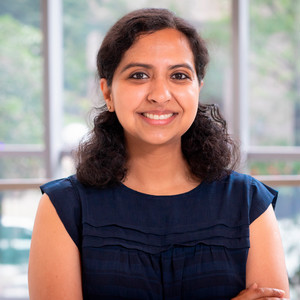
September 2024 Newsletter

September 2024 Newsletter

Student Profile
Aishwarya Ramamurthy is a fifth-year student in the Driskill Graduate Program in Life Sciences (DGP). After completing her bachelor’s degree in engineering and biotechnology at PES University in India, Ramamurthy then pursued her master’s in biochemistry and molecular biology from Indiana University-Purdue University-Indianapolis.
Now she works in the laboratory of Gemma Carvill, PhD, assistant professor in the Ken and Ruth Davee Department of Neurology Division of Epilepsy and Clinical Neurophysiology, where she studies the genetic drivers of rare developmental disorders.
Where is your hometown?
I was born and raised in Bengaluru, a city in the south of India known for its beautiful gardens and the high-technology industry. I moved to the United States after my undergraduate education for my master’s. I have lived in Chicago for the last eleven years and fondly consider it my second home.
What sparked your interest in science or medicine?
The biosciences have been an ever-fascinating area of study for me. In my high school biology class, I was learning about DNA fingerprinting and around the same time, I saw its application in a forensic documentary. Applying basic science concepts to solve real world problems, and engineering clever tools to achieve it, got me excited.
What are your research interests?
Broadly, I am interested in understanding the genetic drivers of rare developmental disorders with the goal to better diagnose them at the clinic and potentially find cures. The role of the non-coding genome in gene regulation has been understudied in neurodevelopmental disorders (NDDs). I intend to establish a regulatory landscape for NDD genes by exploring genetic, epigenetic and 3D genome architecture. Together with access to whole genome, exome and other omics data from large populations worldwide, it brings us closer than ever to solving unexplained genetic epilepsies that often overlap with NDDs. I equally enjoy thinking about new ways to leverage technology to answer these questions.
What are you currently working on?
Structural variants are genetic variants that vary widely in size and include multiple chromosomal modifications. I am studying the impact of epilepsy-associated non-coding structural variants on gene regulation and chromatin architecture. This will aid my attempts to define the molecular mechanisms by which such variants influence epilepsy susceptibility.
Please tell us about a defining moment in your education at Feinberg thus far.
I would like to highlight two training opportunities that were particularly defining for me. Monthly clinical case conferences are held by the Northwestern Adult Epilepsy Genetics Program, co-directed by my mentor Dr. Gemma Carvill, and adult epileptologist Dr. Elizabeth Gerard, where researchers and clinicians come together to discuss cases of epilepsies with a potential genetic etiology. Identifying genetic causes unique to an individual can be especially advantageous to one’s treatment options. I was able to apply my neurogenetics training to diagnose two such cases and their underlying complex genetic factors. It was very encouraging to see my training have an immediate and practical implication. As a Driskill Graduate Program student, I attended clinical case conferences and shadowed Dr. Divakar Mithal, pediatric neurologist at Ann & Robert H. Lurie Children’s Hospital of Chicago, through the Kids-Inspired Innovation for Careers in Science program. I witnessed a team of neurologists, genetic counselors and caregivers working together, over multiple sessions to successfully arrive at a diagnosis and treatment options for a perplexing seizure incidence of a 6-year-old child. It was moving to see the ways in which research in a laboratory setting intersected with medicine. I had a renewed sense of purpose towards my research and an added motivation to contribute to this field.
What do you hope to do with your degree?
I plan to pursue my research interests through academic or industrial postdoctoral opportunities. Long term, I aspire to lead investigations to address current gaps in rare disease diagnostics and therapeutics.